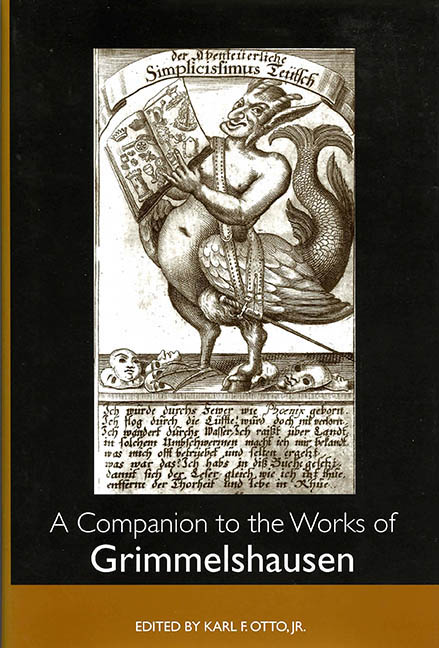Book contents
- Frontmatter
- Contents
- Illustrations
- Acknowledgments
- Chronological List of Grimmelshausen's Works and Their First English Translation
- Introduction
- I Basics
- Problems in the Editions of Grimmelshausen's Works
- Grimmelshausen's “Autobiographies” and the Art of the Novel
- Allegorical and Astrological Forms in the Works of Grimmelshausen with Special Emphasis on the Prophecy Motif
- Grimmelshausen and the Picaresque Novel
- Grimmelshausen's Ewig-währender Calender: A Labyrinth of Knowledge and Reading
- Grimmelshausen's Non-Simplician Novels
- In Grimmelshausen's Tracks: The Literary and Cultural Legacy
- II Critical Approaches
- Notes on the Contributors
- Index
Grimmelshausen and the Picaresque Novel
from I - Basics
Published online by Cambridge University Press: 27 April 2017
- Frontmatter
- Contents
- Illustrations
- Acknowledgments
- Chronological List of Grimmelshausen's Works and Their First English Translation
- Introduction
- I Basics
- Problems in the Editions of Grimmelshausen's Works
- Grimmelshausen's “Autobiographies” and the Art of the Novel
- Allegorical and Astrological Forms in the Works of Grimmelshausen with Special Emphasis on the Prophecy Motif
- Grimmelshausen and the Picaresque Novel
- Grimmelshausen's Ewig-währender Calender: A Labyrinth of Knowledge and Reading
- Grimmelshausen's Non-Simplician Novels
- In Grimmelshausen's Tracks: The Literary and Cultural Legacy
- II Critical Approaches
- Notes on the Contributors
- Index
Summary
The basic structure of Grimmelshausen's picaresque novels, including Courasche, Springinsfeld and his masterpiece, Simplicissimus Teutsch, goes back to the picaresque novels that originated in Spain in the sixteenth century. Among the Spanish examples it is Mateo Alemán's Guzmán de Alfarache (part one 1599, part two 1604) that has been called the prototypical picaresque novel. Aegidius Albertinus (1560–1620), who left his native Holland to settle in Munich where he held a variety of positions at the court, adapted the first part of Alemán's novel and parts of an unauthorized continuation by an otherwise unknown writer, Juan Martí. Albertinus gave his version the title Gusman von Alfarche (1615). Since this adaptation is the most important antecedent for Simplicissimus and since Grimmelshausen apparently did not know Spanish, I will discuss below the many striking parallels as well as the radical differences between the two works.
Spanish literature played a major role in seventeenth-century Germany. Although few were able to read the texts in the original, there were translations into German. In addition, the works were often also available in French, Italian, and Latin. Here one must keep in mind that, while some of the versions followed the original fairly accurately, others departed from it, some in radical ways, as in the case of Albertinus's Gusman von Alfarche. Spanish literature of the sixteenth and seventeenth centuries is often referred to as being of the “Golden Age.” Early on we have the ever so popular prose romance of chivalry, Amadís de Gaula, the first extant version (by Montalvo) of which was printed in 1508. This work, filled with adventure, magic, and love, inspired innumerable variations, translations, such as that of Herberay des Essarts (8 volumes, 1527) and more continuations than any other novel known in literary history. It reached 24 books in the German version completed by 1595. Later on, there were the playwrights like Lope de Vega (1562–1635), who wrote close to 500 plays, and Calderón de la Barca (1600–1681), who is best known for his autos sacramentales (one-act religious plays) and the philosophical La vida es sueño.
- Type
- Chapter
- Information
- A Companion to the Works of Grimmelshausen , pp. 147 - 166Publisher: Boydell & BrewerPrint publication year: 2002



